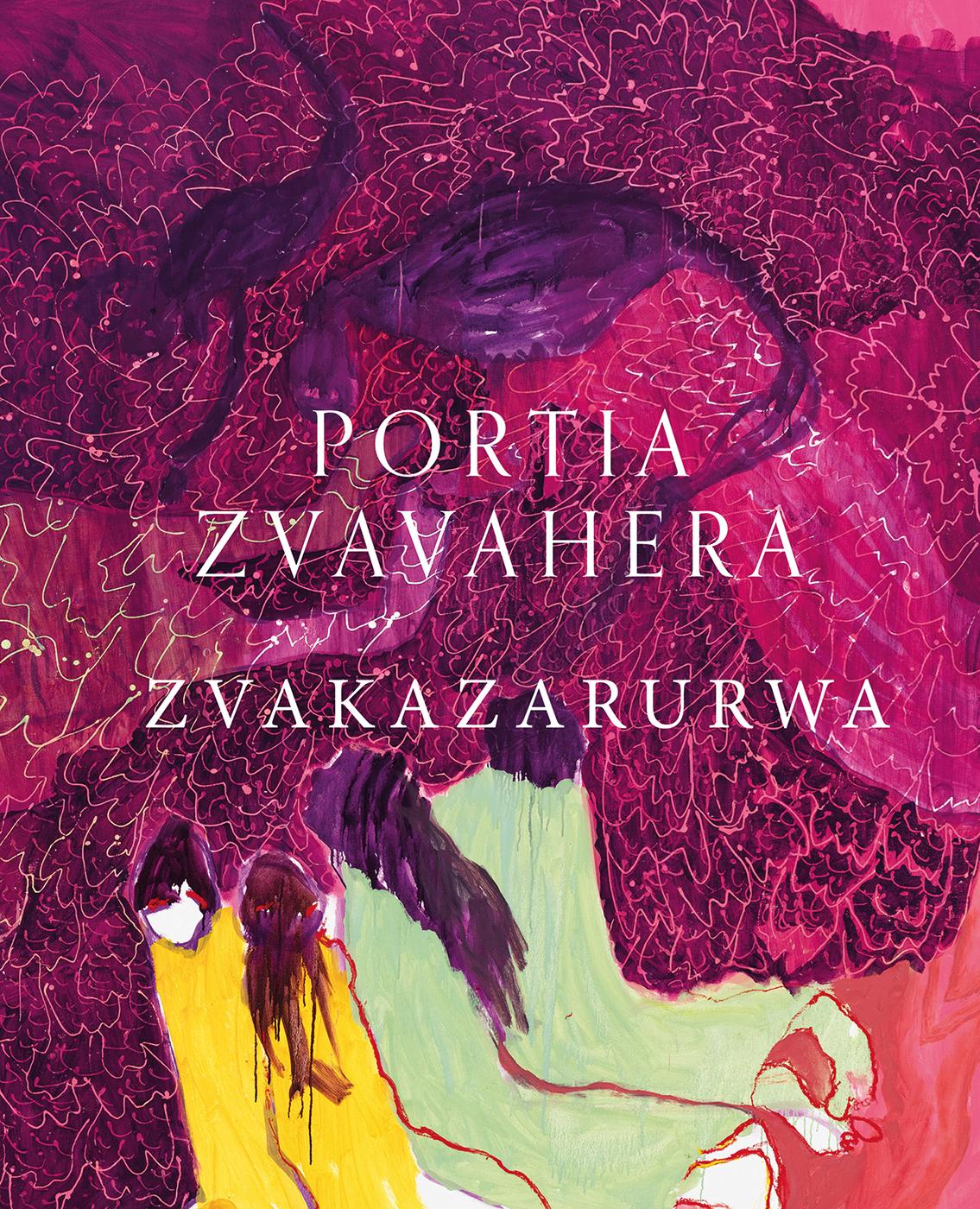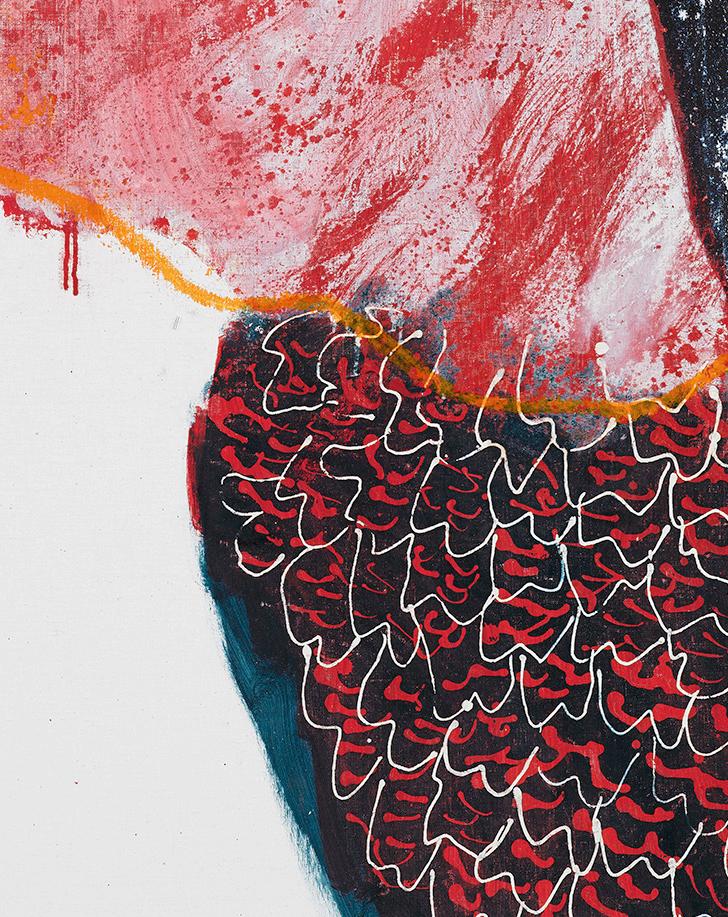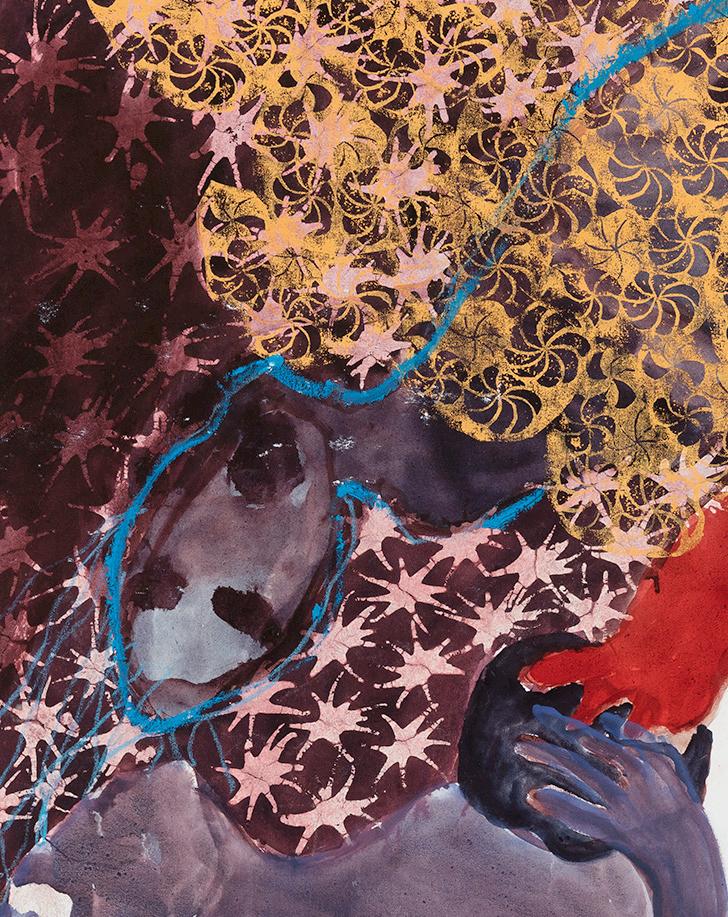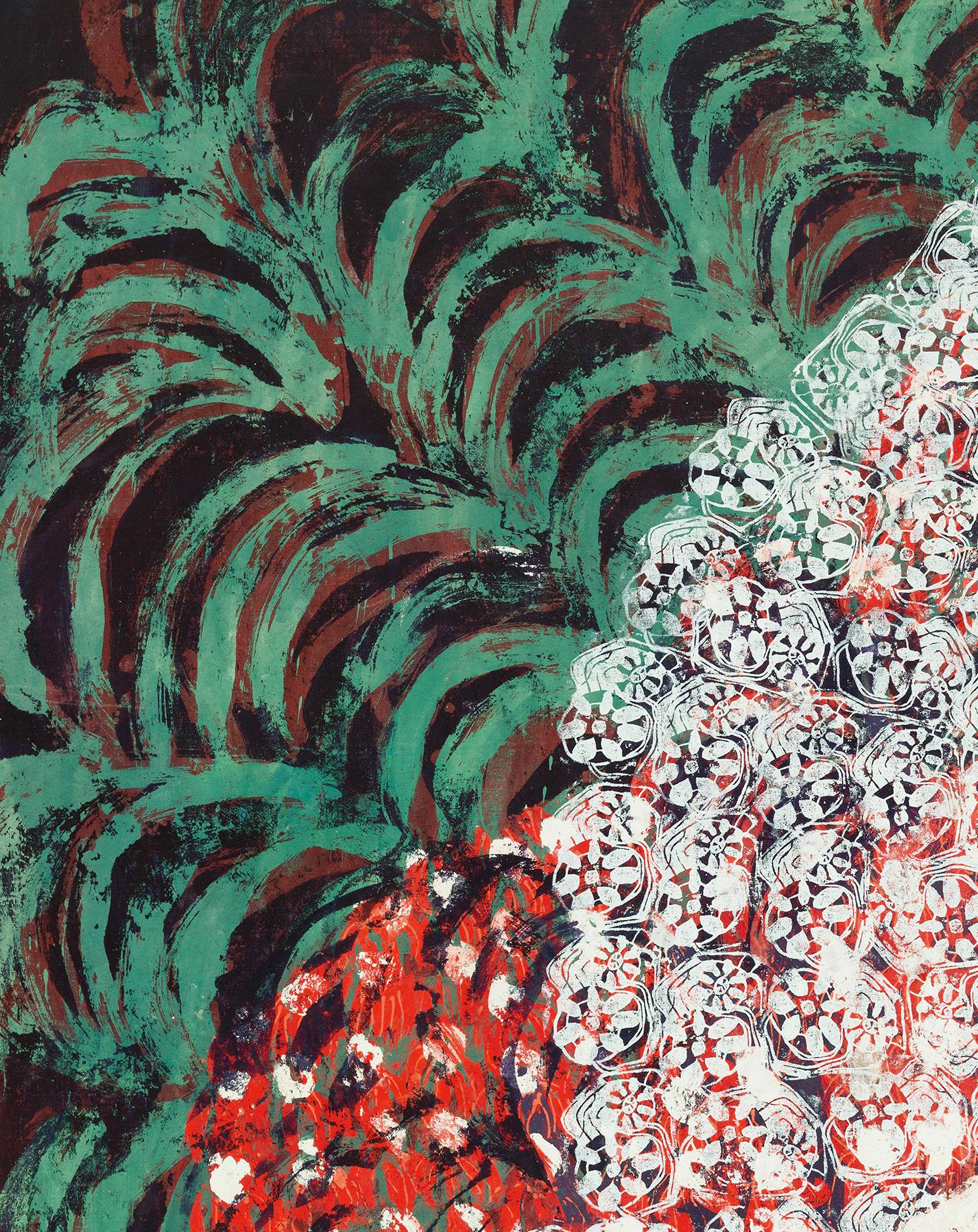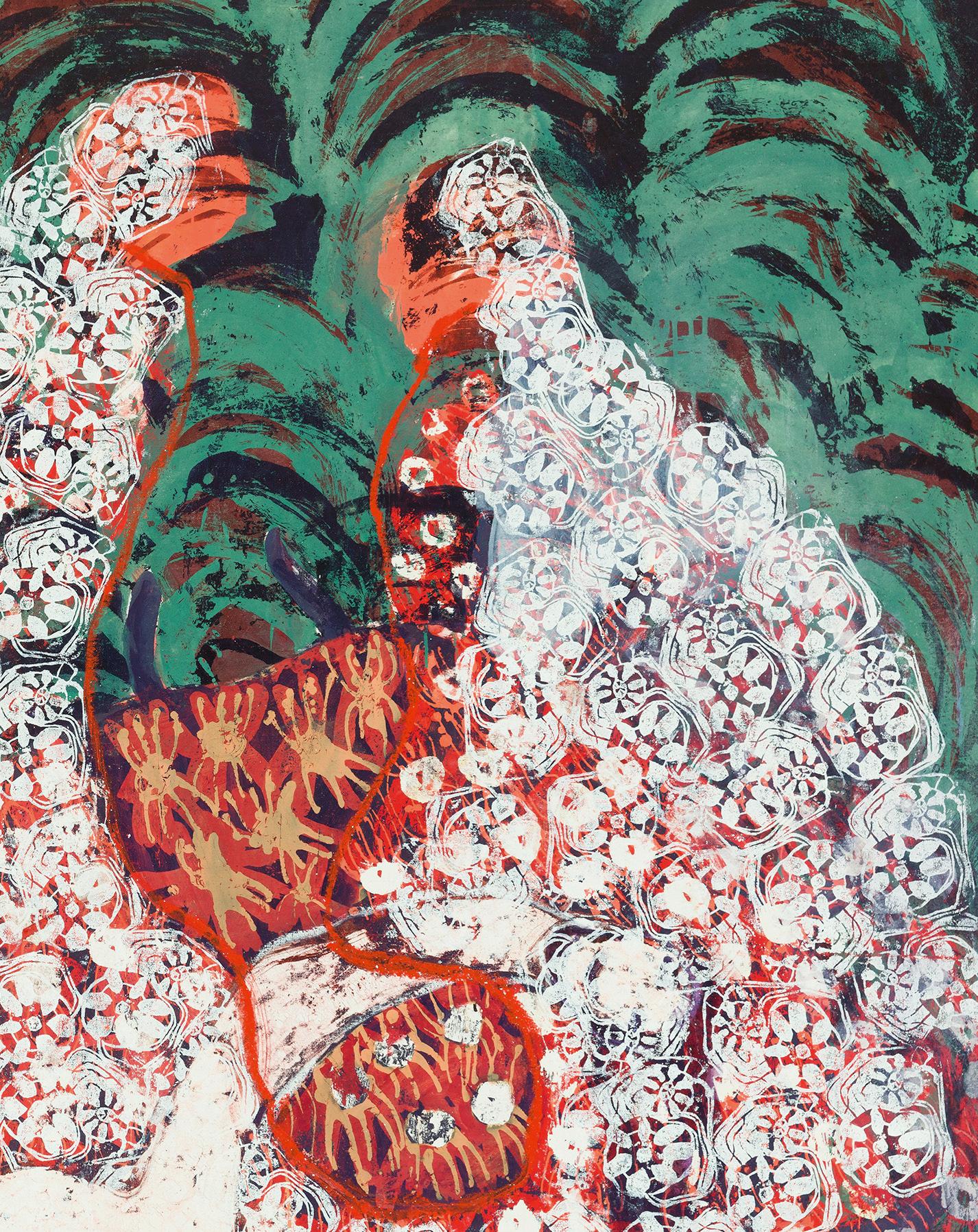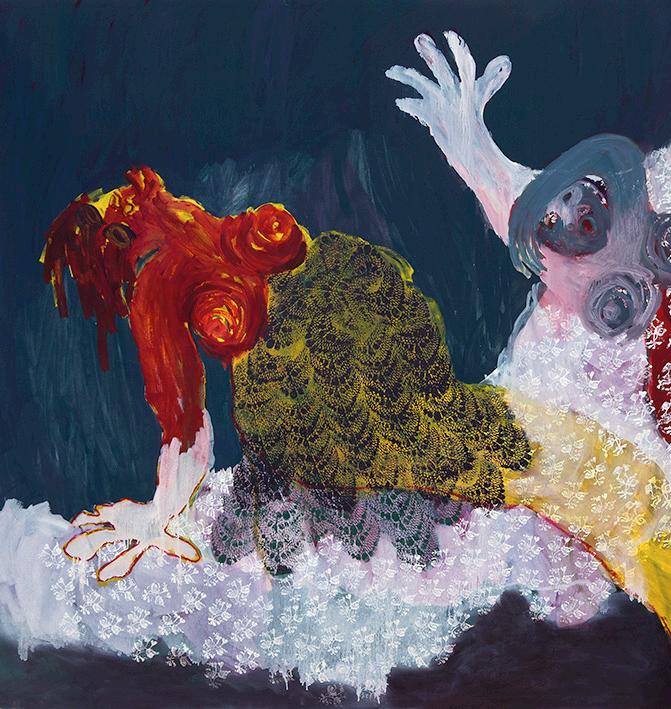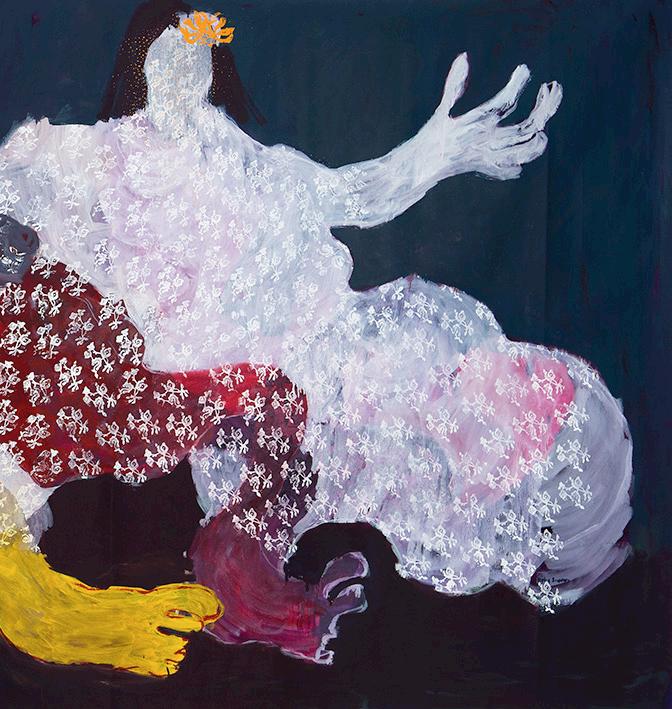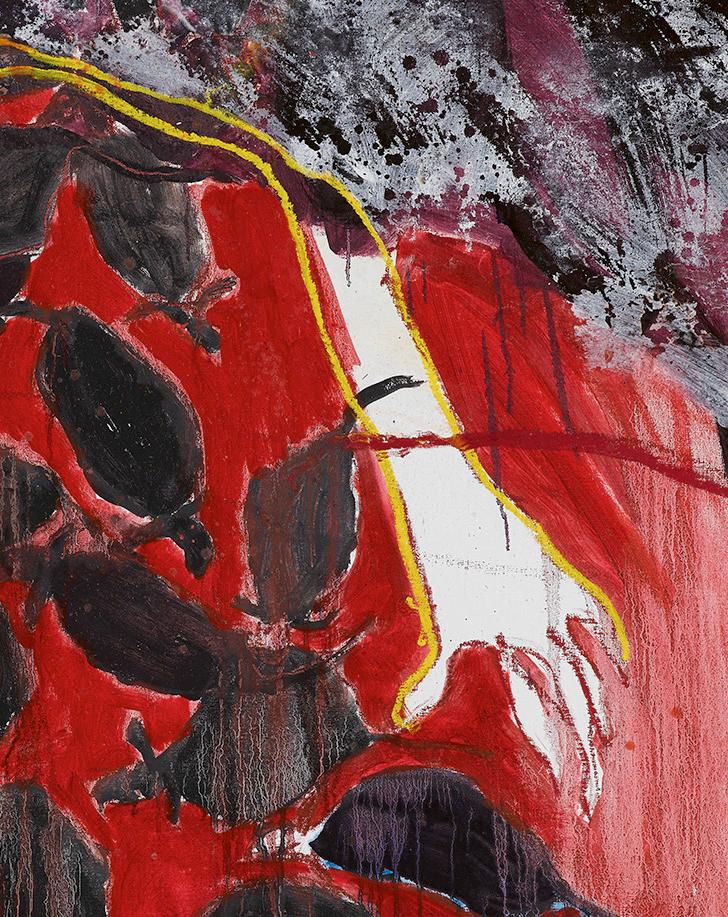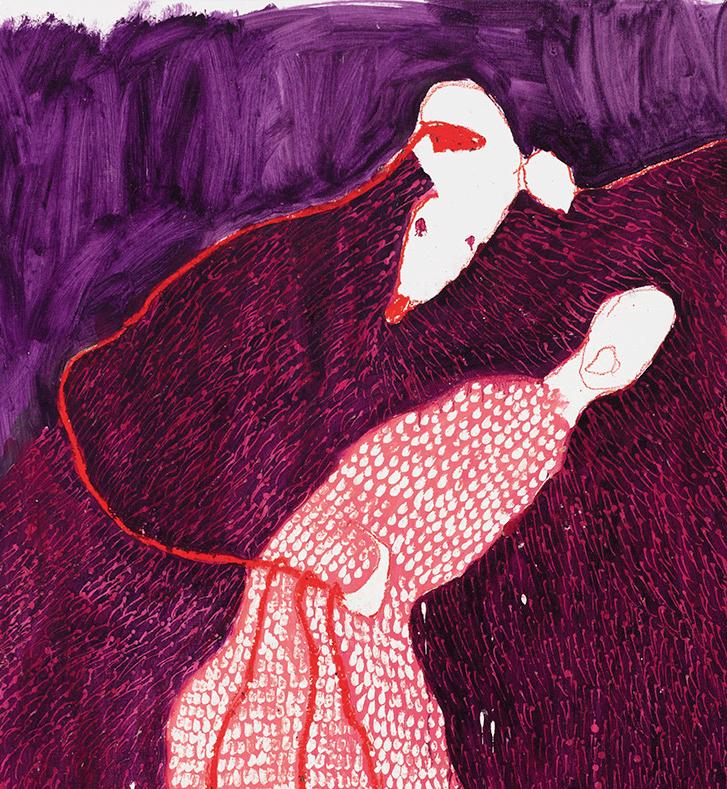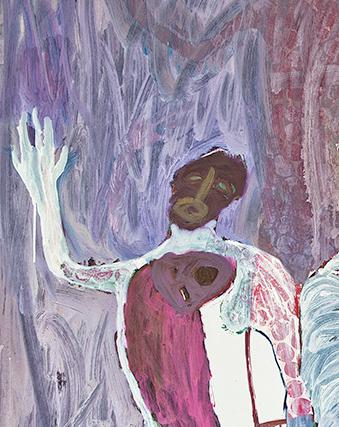DREAMING IN SHONA
TAMAR GARB IN CONVERSATION WITH SINAZO CHIYA TANDAZANI DHLAKAMA PUMLA GOBODO-MADIKIZELA
following pages:
Pane rima rakakomba (1) (There’s too much darkness) 2023
Oil-based printing ink and oil bar on canvas
222 × 332 cm
In July 2023, I invited three women to sit with me in the Stevenson gallery in Cape Town, on the occasion of Portia Zvavahera’s show, Pane rima rakakomba (1) (There’s too much darkness) We talked surrounded by her works and in front of the eponymous canvas that has become a pivotal piece for our exhibitions at Kettle’s Yard, Cambridge and Fruitmarket, Edinburgh. What follows is an edited version of the conversation we shared. Four women, of and from Southern Africa, confronted Zvavahera’s practice, its locatedness and cultural specificity while exploring its connection to a planetary consciousness and the learned and shared languages of art.
TAMAR GARB (TG): About 10 years ago, before Portia Zvavahera became the international phenomenon she now is, I was introduced to her work by her gallerist, Michael Stevenson, and I’ve been talking with him about the work ever since. From the start, I was fascinated by what I think of as a kind of unique language that she has invented – this interface between painting and printmaking that serves as a medium for a personal cosmology and vision. I have only written on her work once before, and that was in the context of a book on the experimental and peripatetic African art school/workshop, ÀSÌKÒ, set up by my dear friend, the late Bisi Silva, who ran it from CCA Lagos, which she founded and directed between 2010 and
2019.1 Portia was one of the first graduates of this programme and Bisi was one of her earliest mentors and guides. She encouraged me to work on Portia and we talked about her work a lot. So, these shows in the UK feel like a tribute to the prescience and brilliance of one of the first African women curators to change the contemporary landscape of art and to bring Black women from the continent into global visibility and prominence.
It would be good to start with an introductory remark from each of you about your own work and your knowledge of and engagement with Portia’s practice.
TANDAZANI DHLAKAMA (TD):
I’m a Zimbabwean curator, currently working at Zeitz Museum of Contemporary Art Africa (MOCAA) in Cape Town. My first memory of encountering Portia’s work was in 2011 when I started working at the National Gallery of Zimbabwe. I saw Portia’s work at Gallery Delta which closed down last year, but which was one of the oldest contemporary art spaces in Harare. Portia always used to have shows with one of her best friends, Virginia Chihota, who also works with printing but in her case in combination with other mediums – drawing, collage etc.
I feel like Portia and Virginia speak a similar language. Virginia uses a lot of printing with
Hauvatore (You cannot take them)
2023 (detail)
consciousness and unconsciousness. I’m not sure if there’s a Shona-specific way of articulating this, or a particularly Zimbabwean and African way of understanding it. Of course, I’m not looking for some kind of ‘authentic’ or ‘pure’ African experience. There’s no such thing. Portia lives between multiple cultures and languages, from her Christian faith to her connection to the ancestors. Dreaming, like waking life, moves between these porous and intermingled identities.
PG-M: Yes, no one wants to use the overused term intersectionality, but I do think we need to integrate various models for understanding dreams, and the Freudian is an unavoidable one. There is an unconscious life, which requires that we consider thinking psychoanalytically. But there’s also the fact of people’s everyday lives, their cultural embeddedness, and the stories and suffering this generates. We need this cultural context, you know? Call it African if you will, and I wouldn’t avoid calling it ‘African’, because this is the cultural heritage from which Portia draws inspiration for her work. And we need to consider the way dreams are a gateway to something that transcends consciousness, perhaps to something in the realm of the spiritual. Here we also need an expansive notion of the spiritual. It’s not necessarily religious, but it’s the spiritual in a much broader sense, something which we often struggle to articulate. How do we think about the spiritual in her paintings? Do the paintings offer a bridge between consciousness and the spiritual, and convey her gift of understanding or seeing beyond? Sometimes people speak about the gift of speaking through the spiritual or articulating the spiritual for the rest of us. In the African context, there is the acceptance that some people are gifted with a power or capacity to transform what is unspoken and exists in the deep unconscious into meaningful messages that can be presented and taken in multiple directions. There is always something central
in the messages. Whether it is: ‘behold, this is what is happening to the rest of us womenfolk’, or ‘behold, this is (a calamity) that awaits us as a community’. Some kind of foretelling or prescience. So, we can understand the unconscious – the wellspring of dreams – in these terms, as a source that can be tapped for new knowledge and inspiration for art. Through the unconscious all of the provocations of life and its anxieties and the unsettling stuff that’s happening, that is beyond rational articulation or narration, find a voice. And here’s where I find artists so interesting. With them there is this connection of the unsayable and ineffable to the hand and the work of the hand. It’s an action, an embodied deeply unconscious action that speaks through the body and the movement of the pen/brush of the artist. So, it’s an integration of the unconscious, the embodied, you know, stuff that is really embedded within the body. All those memories that may be unconscious, but are situated in the body, and how these memories explode into shape and colour and form. So, the dream becomes a mediator between the unconscious and the body. It is integrated and intersected and ultimately explodes or finds form on the canvas or on the page.
TD: In Pentecostal Christianity, a message could either be coming from an evil place or from a holy place. And if it’s coming from an evil place, you need to cancel it – speak against it or do something to stop it. If it is coming from a holy place it’s unveiling truth, which is still linked to the everyday, because we’re talking in this context about not separating spirituality from the natural, what we would call the natural realm. And there’s also this idea that if you don’t write it down, if you don’t document it, you’ll forget the dream. So, I think in Portia’s case, there is this embodied act of painting, but it’s her way of cancelling or inscribing or documenting. It’s tantamount to capturing a message, which of course doesn’t resemble

practice of prayer, it’s beyond meditating, you know, although it’s aligned with meditation. But prayer takes you to another realm if you really give yourself up to the moment of prayer. So, Portia’s being spiritual in prayerful pursuit is central here. That dynamic within the painting space, in the space where she’s engaged in painting, she can do that with her mind. With her unconscious, with her body, she kind of gives herself up so that it’s almost like it performs itself through her. It becomes something that you are living through the spirit, almost like the messages of the spiritual realm. Because in prayer you’re speaking in words, but also through your body while imagining the existence of something beyond yourself. The painting becomes a kind of a dialogue. A prayerful dialogue.
SC: I’m interested in how you’re positioning the connection between painting and praying. This makes sense of the way Portia can be both in the present with the canvas but also in another realm. So, the discrepancy between waking life and sleeping life narrows when she’s working. It’s almost as though she is praying on/through the canvas. It’s an embodied action that allows her to connect to the negative messages and spirits animated in sleep by the dream: her demons, so to speak. It’s as though she’s excavating the ‘within’ in the act of painting, and then it all collapses, even if it’s not illustrative. It’s how she makes the collapse.
TD: I agree about the potential different states of being, but I wonder… I’m grappling with the word sleeping because perhaps in the dream, you’re more awake than when you are awake. And so, I think this is a different state of being because sleeping feels passive, but I think there’s something active, whether she’s physically asleep or awake. I think for me, her dreaming is more like a state of heightened awakeness.
And then relating this to the idea of multiple consciousnesses and the possibilities of
‘dreaming in Shona’ and being bilingual. I think being African is to have multiple consciousnesses, because that’s just our heritage. So, in some cases it becomes laborious like compulsory code-switching, but in some cases it’s just normal life. You know most Africans speak many languages and that affects our beings, into our thinking, and into our dreaming as well. I don’t think many of us dream monolingually.
And then in relation to prayer, I’m reminded of the word wrestling. There is this tension, if you look at the artwork and the brushstrokes and the movement of the brush, it’s not necessarily violent, but there is a tension, a wrestling. And if you think of biblical narratives as well and Portia’s drawing from biblical sources amongst many things, the wrestling emerges in the imagery as well as the act of making. Jacob wrestled with God, and this stands for an inner struggle of faith and trust and surrender. So, there is this idea of wrestling through prayer or spiritual warfare, but it’s not necessarily a violent thing – it can be meditative or contemplative. So, I really love what has come up around this idea of prayer. Of course, Portia did create a series of works where she was literally praying, or at least the figure in the work is shown to be praying or kneeling, and supplicating figures recur. Perhaps they stand against the darkness that engulfs her, in the night, in the unknowable half-light. With these praying figures. There are ominous creatures, like the rat, which serves as a metaphor for something antagonising or harmful. But she has to document it, or wrestle with it or face it in order for that prayer to unfold…
PG-M: It has to be exorcised.
TG: I think also this goes back to what you were saying earlier, Tandazani, about having to understand that the mythology is not necessarily comforting and often works in terms of the menacing or gloomy. Take the rat, for example, it has a very particular kind
Prayer amid a battle
All works illustrated courtesy the artist unless otherwise stated.
Copyright Portia Zvavahera, courtesy Stevenson and David Zwirner.
All images rights reserved.
© 2024 Fruitmarket, the artists, authors and photographers.
All rights reserved.
Photography by Anna Arca
Stephen Arnold Gideon Gomo
Jack Hems
Anthea Pokroy, Mario Todeschini
p.35: Courtesy the artist, photo: © Chikonzero Chazunguza
p.43
p.48: The Museum of Modern Art, New York/Scala, Florence 2024 © Photo Scala, Florence
No part of this book may be used or reproduced in any manner without written permission from the publisher, except in the context of reviews. The publisher has made every effort to contact all copyright holders. If proper acknowledgement has not been made, we ask copyright holders to contact the publisher.
